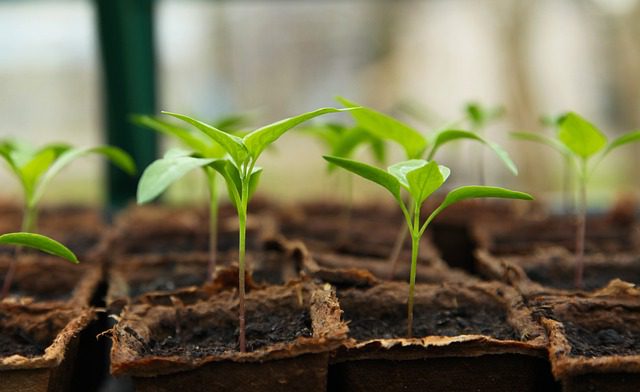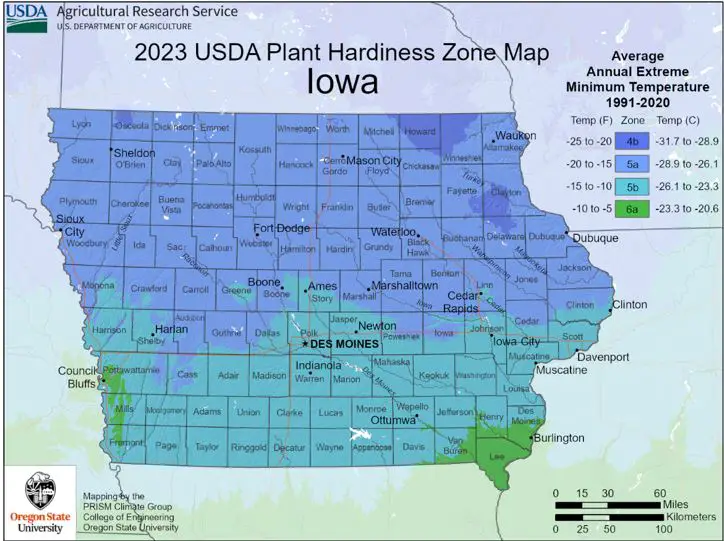This article contains affiliate links. In other words, if you click on an affiliate link and buy a product, this blog may receive compensation at no cost to you. See our full disclosure here.

This year, get a head start on gardening by starting seeds indoors during the winter! Not only will you get a jump start on the growing season, but you’ll save money too! The good news is it’s easy to start seeds indoors. But don’t know what to start and when? We’re here to help! Here’s our guide for when to start seeds indoors in Iowa (and how to do it).
Table of Contents
- Iowa planting (hardiness) zones
- When to start seeds indoors in Iowa
- What you need to start garden seeds indoors
Iowa planting (hardiness) zones
Before starting seeds, the first thing to know is your hardiness zone (e.g., planting zone). Most of Iowa is Zone 5, but some northern parts are in Zone 4b, and some southern areas are in Zone 6a.
Central Iowa is in zones 5a and 5b, depending on the exact location. The USDA Plant Hardiness Zone Map can help you find your zone.

When to start seeds indoors in Iowa
When to start seeds depends on your zone, types of plants, and when you will transplant the seedlings.
In Iowa, most seeds can be started in mid-late February and transplanted into the garden in May (the rule of thumb is after Mother’s Day). But, it depends on the type of plant.
Winter Sowing Seeds: List of best seeds to winter sow and how to do it
What seeds to start indoors and when
Some seedlings tolerate transplanting. But others should be sown in the garden after the threat of frost has passed. (In Des Moines, the average last day of frost is April 25.)
Here, we only start seeds we know transplant well and need a longer growing season. So, for example, we start peppers, tomatoes, and some herbs. Other contenders include eggplant, broccoli, cauliflower, and brussels sprouts.
Tomatoes, peppers, and eggplants get started about 6-8 weeks before the last frost date, so late February and March. Everything else gets planted in the garden in April and early May.
According to Almanac.com, here’s when to start some seeds and transplant them.
| Plant | When to start | When to transplant |
|---|---|---|
| Basil | Feb 25 – March 11 | April 23 – May 14 |
| Bell Peppers | Feb 11-25 | April 30 – May 14 |
| Broccoli | Feb 25 – March 11 | March 26 – April 16 |
| Cabbage | Feb 25 – March 11 | March 26 – April 9 |
| Cauliflower | Feb 25 – March 11 | March 26 – April 16 |
| Celery | Feb 11-25 | April 30 – May 14 |
| Eggplants | Feb 11-25 | May 7-15 |
| Kale | Feb 25 – March 11 | March 26 – April 16 |
| Kohlrabi | March 11-26 | April 2-9 |
| Oregano | Feb 11 – March 11 | April 23 – May 14 |
| Rosemary | Feb 11-25 | April 30 – May 21 |
| Sage | Feb 25 – March 11 | April 23 – May 7 |
| Sweet Potatoes | March 26 – April 2 | May 7-21 |
| Swiss Chard | March 11-26 | April 2-9 |
| Thyme | Feb 11- March 11 | April 23 – May 14 |
| Tomatoes | Feb 25 – March 11 | April 30 – May 21 |
You can start squash, watermelons, and cantaloupe seeds, but they don’t always like to get moved to the garden. In our experience, they do best when sown in the garden. But we’re not experts either, so definitely experiment to see what works for you!
Seeds to start outdoors in Iowa
As mentioned earlier, our growing season isn’t long enough to start all garden seeds outdoors. For example, tomatoes, peppers, and eggplants need to start early to produce in July and August. And some of the cool weather varieties, like broccoli and cauliflower, do well when they have a jump start.
But, from our experience, many other seeds do best when sown in the garden. So, around here, we start many seeds outdoors.
Here are seeds to start outdoors:
- Arugula
- Beets
- Cantaloupe
- Carrots
- Chives
- Cilantro
- Corn
- Cucumbers
- Dill
- Green Beans
- Lettuce
- Okra
- Onions
- Parsley
- Parsnips
- Peas
- Potatoes
- Pumpkins
- Radishes
- Spinach
- Turnips
- Watermelon
- Zucchini
What you need to start garden seeds indoors
You can invest in seed starting kits*, plant shelves with grow lights*, and more for starting seeds indoors. But it doesn’t have to be complicated, and you don’t need special equipment. We take a straightforward, frugal approach to seed starting.
• Seed starting mix
Use a sterile seed starting mix or another soilless mix. Regular soil can limit drainage and promote mold.
• Pots/planters
We clean and reuse pots and save yogurt containers for starting seeds. You can also make paper pots and start seeds in box flats and even egg cartons. Just make sure your containers have drainage.
• Warmth
Seeds germinate best when between 70-80°F. We place them near a heating vent, but you can also buy waterproof heating mats* to aid germination. Also, put plastic over them to create a mini-greenhouse until most seeds germinate. Once they begin growing, they no longer need as much warmth, and any plastic should get removed.
• Light
Once the seeds germinate, they need plenty of light to grow and thrive. Placing them near a window with direct sunlight works for a while. But once they get the first set of true leaves, they do best with a source of supplemental, artificial light. We use a $30 grow light* purchased online, and fluorescent shop lights work too.
• Water
Before the seedlings germinate, the soil should stay moist. After that, check the seedlings often and water them when they dry out.
Hardening off your seedlings
We get much (much!) better results when we harden off seedlings before transplanting. Hardening off makes plants more robust and healthy. And it helps them transplant more readily.
After the seeds are a few inches tall, we place a fan a few feet away and turn it on for a couple of hours a day to help them get stronger.
And to harden them off, we put them outdoors each day a few days before transplanting them. Start with short amounts of time, and gradually leave them outside longer and longer. It helps them acclimate to the direct sunlight and outdoor elements.
If you live in Iowa, start some garden seeds indoors this year! What better way to beat the winter blahs than to get ready for spring?
Iowa gardening resources
- Iowa State Extention Gardening Resources
- Gardening in Iowa and Surrounding Areas*
- The Iowa Gardener
- Midwest Fruit and Vegetable Gardening*
- Gardening in the Midwest | Better Homes & Gardens
Next:
- Winter Sowing Seeds: Best seeds to winter sow and how to do it
- Composting in Winter? Top Tips for Compost During Cold Weather
- Gardening Gifts For Dad: 10 Gifts He’ll Love
*Amazon affiliate link
Photo credit: Pixabay
